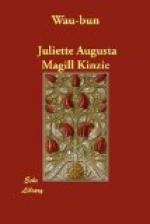It seems a singular fatality that the unhappy mother should have been twice called to suffer a similar affliction—the loss of a child in a manner worse than death, inasmuch as it left room for all the horrors that imagination can suggest. The particulars of the loss of this little brother were these. As he came from school one evening, he met the colored servant-boy on horseback, going to the common for the cows. The school-house stood quite near the old fort, and all beyond that, towards the west, was a wild, uncultivated tract called “the Common.” The child begged of the servant to take him up and give him a ride, but the other refused, bidding him return home at once. He was accompanied by two other boys, somewhat older, and together they followed the negro for some distance, hoping to prevail upon him to give them a ride. As it grew dark, the two older boys turned back, but the other kept on. When the negro returned he had not again seen the child, nor were any tidings ever received of him, notwithstanding the diligent search made by the whole little community, until, as related in the record, his remains were found the following year by an Indian. There was nothing to identify them, except the auburn curls of his hair, and the little boots he had worn. He must have perished very shortly after having lost his way, for the Prairie Ronde was too near the settlement to have prevented his bearing the calls and sounding horns of those in search of him, had he been living.
Mr. Kinzie’s enterprising and adventurous disposition led him, as he grew older, to live much on the frontier. He early entered into the Indian trade, and had establishments at Sandusky and Maumee. About the year 1800 he pushed farther west, to St. Joseph’s, Michigan. In this year he married Mrs. McKillip, the widow of a British officer, and in 1804 came to make his home at Chicago. It was in this year that the first fort was built by Major John Whistler.
By degrees more remote trading-posts were established by him, all contributing to the parent one at Chicago; at Milwaukie with the Menomonees; at Rock River with the Winnebagoes and the Pottowattamies; on the Illinois River and Kankakee with the Pottowattamies of the Prairies, and with the Kickapoos in what was called “Le Large,” being the widely extended district afterwards erected into Sangamon County.
Each trading-post had its superintendent, and its complement of engages—its train of pack-horses and its equipment of boats and canoes. From most of the stations the furs and peltries were brought to Chicago on pack-horses, and the goods necessary for the trade were transported in return by the same method.
The vessels which came in the spring and fall (seldom more than two or three annually), to bring the supplies and goods for the trade, took the furs that were already collected to Mackinac, the depot of the Southwest and American Fur Companies. At other seasons they were sent to that place in boats, coasting around the lake.




